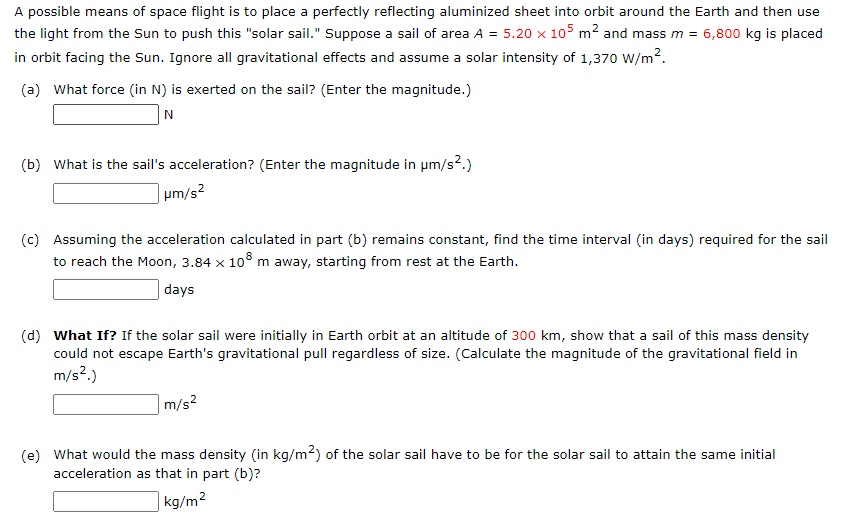A possible means of space flight is to place a perfectly reflecting aluminized sheet into orbit around the Earth and then use the light from the Sun to push this "solar sail." Suppose a sail of area A = 5.20 ✕ 105 m2 and mass m = 6,800 kg is placed in orbit facing the Sun. Ignore all gravitational effects and assume a solar intensity of 1,370 W/m2. (a) What force (in N) is exerted on the sail? (Enter the magnitude.) N (b) What is the sail's acceleration? (Enter the magnitude in µm/s2.) µm/s2 (c) Assuming the acceleration calculated in part (b)
A possible means of space flight is to place a perfectly reflecting aluminized sheet into orbit around the Earth and then use the light from the Sun to push this "solar sail." Suppose a sail of area A = 5.20 ✕ 105 m2 and mass m = 6,800 kg is placed in orbit facing the Sun. Ignore all gravitational effects and assume a solar intensity of 1,370 W/m2. (a) What force (in N) is exerted on the sail? (Enter the magnitude.) N (b) What is the sail's acceleration? (Enter the magnitude in µm/s2.) µm/s2 (c) Assuming the acceleration calculated in part (b)
Physics for Scientists and Engineers: Foundations and Connections
1st Edition
ISBN:9781133939146
Author:Katz, Debora M.
Publisher:Katz, Debora M.
Chapter34: Maxwell’s Equations And Electromagnetic Waves
Section: Chapter Questions
Problem 32PQ
Related questions
Question
A possible means of space flight is to place a perfectly reflecting aluminized sheet into orbit around the Earth and then use the light from the Sun to push this "solar sail." Suppose a sail of area A = 5.20 ✕ 105 m2 and mass m = 6,800 kg is placed in orbit facing the Sun. Ignore all gravitational effects and assume a solar intensity of 1,370 W/m2.
(a)
What force (in N) is exerted on the sail? (Enter the magnitude.)
N
(b)
What is the sail's acceleration? (Enter the magnitude in µm/s2.)
µm/s2
(c)
Assuming the acceleration calculated in part (b) remains constant, find the time interval (in days) required for the sail to reach the Moon, 3.84 ✕ 108 m away, starting from rest at the Earth.
days
(d)
What If? If the solar sail were initially in Earth orbit at an altitude of 300 km, show that a sail of this mass density could not escape Earth's gravitational pull regardless of size. (Calculate the magnitude of the gravitational field in m/s2.)
m/s2
(e)
What would the mass density (in kg/m2) of the solar sail have to be for the solar sail to attain the same initial acceleration as that in part (b)?
kg/m2

Transcribed Image Text:A possible means of space flight is to place a perfectly reflecting aluminized sheet into orbit around the Earth and then use
the light from the Sun to push this "solar sail." Suppose a sail of area A = 5.20 x 105 m2 and mass m = 6,800 kg is placed
in orbit facing the Sun. Ignore all gravitational effects and assume a solar intensity of 1,370 w/m2.
(a) What force (in N) is exerted on the sail? (Enter the magnitude.)
N
(b) What is the sail's acceleration? (Enter the magnitude in um/s2.)
| um/s?
(c) Assuming the acceleration calculated in part (b) remains constant, find the time interval (in days) required for the sail
to reach the Moon, 3.84 x 10° m away, starting from rest at the Earth.
days
(d) What If? If the solar sail were initially in Earth orbit at an altitude of 300 km, show that a sail of this mass density
could not escape Earth's gravitational pull regardless of size. (Calculate the magnitude of the gravitational field in
m/s?.)
m/s?
(e) What would the mass density (in kg/m2) of the solar sail have to be for the solar sail to attain the same initial
acceleration as that in part (b)?
kg/m2
Expert Solution
This question has been solved!
Explore an expertly crafted, step-by-step solution for a thorough understanding of key concepts.
This is a popular solution!
Trending now
This is a popular solution!
Step by step
Solved in 2 steps with 2 images

Knowledge Booster
Learn more about
Need a deep-dive on the concept behind this application? Look no further. Learn more about this topic, physics and related others by exploring similar questions and additional content below.Recommended textbooks for you

Physics for Scientists and Engineers: Foundations…
Physics
ISBN:
9781133939146
Author:
Katz, Debora M.
Publisher:
Cengage Learning

Principles of Physics: A Calculus-Based Text
Physics
ISBN:
9781133104261
Author:
Raymond A. Serway, John W. Jewett
Publisher:
Cengage Learning

Physics for Scientists and Engineers with Modern …
Physics
ISBN:
9781337553292
Author:
Raymond A. Serway, John W. Jewett
Publisher:
Cengage Learning

Physics for Scientists and Engineers: Foundations…
Physics
ISBN:
9781133939146
Author:
Katz, Debora M.
Publisher:
Cengage Learning

Principles of Physics: A Calculus-Based Text
Physics
ISBN:
9781133104261
Author:
Raymond A. Serway, John W. Jewett
Publisher:
Cengage Learning

Physics for Scientists and Engineers with Modern …
Physics
ISBN:
9781337553292
Author:
Raymond A. Serway, John W. Jewett
Publisher:
Cengage Learning
